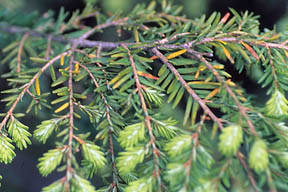Hemlock Rust Mite | |
|---|---|
| May 9, 2008 | |
|
Hemlock rust mite, Nalepella tsugifoliae, feeds primarily on the undersides of hemlock needles in the spring. This is an eriophyid mite, which is much smaller than a spider mite, being visible only with a higher-power hand lens or microscope. The mites are cigar-shaped, with only four legs at the front end. Unlike many eriophyid mites that tend to hide in buds, these mites are easily seen on the leaf undersides with enough magnification.  Hemlock rust mite damage Their feeding causes the foliage to turn bluish and then yellowish before dropping. Because they are primarily spring feeders, the foliage at the tips of the branches will look fine because it developed after most feeding ceased last spring. Older foliage farther back on the branch will show feeding damage or be bare from needle drop. Hemlock rust mite damage is seen mainly in northern Illinois. The mite overwinters as eggs laid on the needles, and those mites are already actively feeding this spring. They hatch early in the spring, being first susceptible to miticide sprays when saucer magnolia is in the pink bud stage. Not all miticides are effective in controlling eriophyid mites. Abamectin (Avid), bifenthrin (Onyx), insecticidal soap, summer spray oil, and spiromesifen (Forbid) provide effective control. Remember that the mites are primarily on the leaf underside, so be sure to get thorough spray coverage there. If insecticidal soap or summer spray oil is used, apply twice, 1 week apart; the other miticides should provide control with one application. (Phil Nixon and Morton Arboretum) | |
| Author: | Morton Arboretum Phil Nixon |
